22 May Music & Dance Events are Back Outside at the Folk School this season!
[vc_row css_animation="" row_type="row" use_row_as_full_screen_section="no" type="full_width"...

[vc_row css_animation="" row_type="row" use_row_as_full_screen_section="no" type="full_width"...
[vc_row css_animation="" row_type="row" use_row_as_full_screen_section="no" type="full_width"...
[vc_row css_animation="" row_type="row" use_row_as_full_screen_section="no" type="full_width"...
We are thrilled to announce...
...
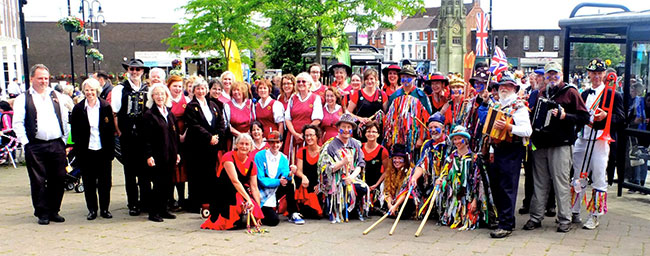 The Brasstown Morris Teams in England. (Carl and his red trombone are on the far right.)[/caption]
There are all sorts of traditions that are alive and well at the Folk School. The Brasstown Fire Department always brings the firetruck to spray down all the children during Little/Middle Folk School, we always dance the Salty Dog Rag during the evening break at Saturday night dances, and the Brasstown Brigade always helps us bring in the New Year with their black powder muskets. One of my favorite Folk School traditions is the Brasstown Follies, the talent show that happens each Winter Dance Week the night before New Years Eve. For as long as I've been coming to Winter Dance Week, the Follies have been organized and MC'ed by Carl Dreher - dancer, musician, magician, and all around Brasstown enthusiast. So enthusiastic, in fact, that he and his wife Charlotte Bristow recently retired and decided to move here from Texas. Let's meet Carl...
[caption id="attachment_12107" align="alignright" width="253"]
The Brasstown Morris Teams in England. (Carl and his red trombone are on the far right.)[/caption]
There are all sorts of traditions that are alive and well at the Folk School. The Brasstown Fire Department always brings the firetruck to spray down all the children during Little/Middle Folk School, we always dance the Salty Dog Rag during the evening break at Saturday night dances, and the Brasstown Brigade always helps us bring in the New Year with their black powder muskets. One of my favorite Folk School traditions is the Brasstown Follies, the talent show that happens each Winter Dance Week the night before New Years Eve. For as long as I've been coming to Winter Dance Week, the Follies have been organized and MC'ed by Carl Dreher - dancer, musician, magician, and all around Brasstown enthusiast. So enthusiastic, in fact, that he and his wife Charlotte Bristow recently retired and decided to move here from Texas. Let's meet Carl...
[caption id="attachment_12107" align="alignright" width="253"]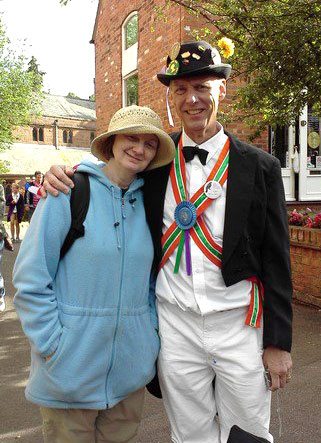 Carl & Charlotte at Kenilworth Castle.
Carl & Charlotte at Kenilworth Castle. 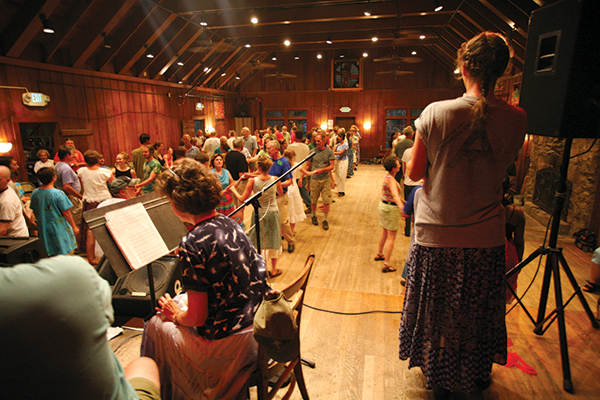 Charlotte calls a contra dance in the Community Room.[/caption]
CP: How long have you been calling at the Folk School?
CC: I came to the Folk School as a Work/Study in the winter of 2006 and I took Bob Dalsemer’s Dance Callers' Workshop that summer. So technically I’ve been calling since 2006, but I wasn’t calling regularly 'till a little time after that.
CP: Why did you get into dance calling?
CC: I’d been a contra dancer for a long time. When I was in elementary, high school and college I was involved in other kinds of dance, so I’ve always had a history of being interested in dancing. I wanted to be a provider of the activity as opposed to just a consumer. Recognizing that my skills as a musician might be a little lacking (laughs), I embraced calling as the next fun way I could be able to do that.
[caption id="attachment_11666" align="alignright" width="340"]
Charlotte calls a contra dance in the Community Room.[/caption]
CP: How long have you been calling at the Folk School?
CC: I came to the Folk School as a Work/Study in the winter of 2006 and I took Bob Dalsemer’s Dance Callers' Workshop that summer. So technically I’ve been calling since 2006, but I wasn’t calling regularly 'till a little time after that.
CP: Why did you get into dance calling?
CC: I’d been a contra dancer for a long time. When I was in elementary, high school and college I was involved in other kinds of dance, so I’ve always had a history of being interested in dancing. I wanted to be a provider of the activity as opposed to just a consumer. Recognizing that my skills as a musician might be a little lacking (laughs), I embraced calling as the next fun way I could be able to do that.
[caption id="attachment_11666" align="alignright" width="340"]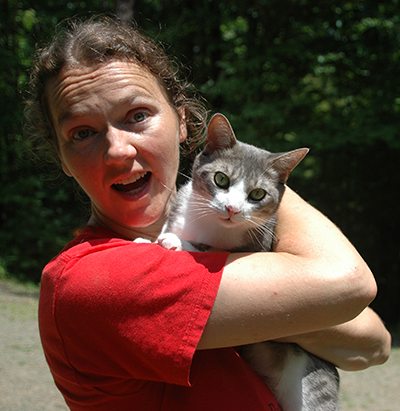 Charlotte & Charlie[/caption]
CP: What’s the best thing about calling a dance at the Folk School?
CC: What a good question! I’d say the dance community at the Folk School is one of the best for integrating all kinds of different folks. People who have been dancing for years and years and years are dancing on the same floor as those who have never ever done it before. Little kids all the way up to folks in their 70s and 80s - all on the same dance floor and everyone’s having a great time, enjoying each other's company. That’s the best part!
CP: Do you have a favorite tune?
CC: I really like the old time tune called Growling & Grumbling, which I love as a dance tune. It got this great low, mumbly beginning and then it busts into this fun, upbeat tune.
CP: Is that the same tune as Growling Old Man and Grumbling Old Woman?
CC: Yep! That’s the one! It a great tune.
CP: Where do you get your dances from?
CC: Oh goodness! Lots of sources. Primarily (and I’d say traditionally) from other callers, but also from going to other dances. I’ll go to a dance and enjoy something that I just danced, run over to the side and write it down real quick.
So I collect dances from dancing. I collect dances from other callers. And in our modern day & age, the internet is a wonderful place, not only to collect dances right off the web, but also to find literature from different places. I use the Country Dance & Song Society which is an organization up in Massachusetts that promotes folk dance and music. I peruse their bookstore pretty frequently. They are a great resource for all things dance.
Charlotte & Charlie[/caption]
CP: What’s the best thing about calling a dance at the Folk School?
CC: What a good question! I’d say the dance community at the Folk School is one of the best for integrating all kinds of different folks. People who have been dancing for years and years and years are dancing on the same floor as those who have never ever done it before. Little kids all the way up to folks in their 70s and 80s - all on the same dance floor and everyone’s having a great time, enjoying each other's company. That’s the best part!
CP: Do you have a favorite tune?
CC: I really like the old time tune called Growling & Grumbling, which I love as a dance tune. It got this great low, mumbly beginning and then it busts into this fun, upbeat tune.
CP: Is that the same tune as Growling Old Man and Grumbling Old Woman?
CC: Yep! That’s the one! It a great tune.
CP: Where do you get your dances from?
CC: Oh goodness! Lots of sources. Primarily (and I’d say traditionally) from other callers, but also from going to other dances. I’ll go to a dance and enjoy something that I just danced, run over to the side and write it down real quick.
So I collect dances from dancing. I collect dances from other callers. And in our modern day & age, the internet is a wonderful place, not only to collect dances right off the web, but also to find literature from different places. I use the Country Dance & Song Society which is an organization up in Massachusetts that promotes folk dance and music. I peruse their bookstore pretty frequently. They are a great resource for all things dance.
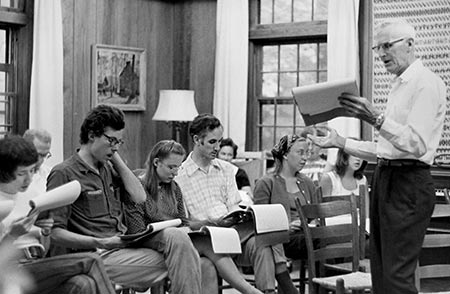 Shape Note Singers with Richard Moss in the Keith House at the Folk School, 1978[/caption]
For anyone who loves to belt it out in the shower, was moved by the church scene in Cold Mountain with everyone belting it out together, or is simply a fan of “belting it out” in life, Shape Note singing is for you!
Every time I have participated in a sing, I have been overcome with the sort of pure emotion that stems from being truly “in the moment” without even realizing it. It is incredibly refreshing and I whole-heartedly recommend it as a great way to spend a summer-time Saturday.
My top 10 favorite things about Shape Note singing (in no particular order):
#1. You don’t have to know how to read music or find harmonies. You can just relax and follow the singing leaders and shapes that resemble each note on the page.
#2. Sitting next to a seasoned singer helps you sound like a seasoned singer (It’s the same theory as a lead biker “breaking the wind” for the riders behind them).
#3. The more raw, gutsy and untrained your way of singing, the better it sounds.
#4. You are not alone! This is true togetherness through song. It is basically a room full of 4 part harmonies happening simultaneously. A perfect opportunity to melt into the crowd.
#5. The harmonies are so different from what you typically hear. They sound so old and heart wrenching… SO beautiful.
#6. Singing increases oxygen to the brain, releases endorphins and reduces stress. All good things, right?
#7. It is a different way to meet folks from our region. At the Folk School sing North Carolina, South Carolina, Georgia, Tennessee and even Alabama are often represented.
#8. It is a safe space for people of all different beliefs and is simply intended as a mode to celebrate joyful living.
#9. The Saturday sing doesn’t drain your go-out-and-have-fun budget. It’s free!
…and last, but not least
Shape Note Singers with Richard Moss in the Keith House at the Folk School, 1978[/caption]
For anyone who loves to belt it out in the shower, was moved by the church scene in Cold Mountain with everyone belting it out together, or is simply a fan of “belting it out” in life, Shape Note singing is for you!
Every time I have participated in a sing, I have been overcome with the sort of pure emotion that stems from being truly “in the moment” without even realizing it. It is incredibly refreshing and I whole-heartedly recommend it as a great way to spend a summer-time Saturday.
My top 10 favorite things about Shape Note singing (in no particular order):
#1. You don’t have to know how to read music or find harmonies. You can just relax and follow the singing leaders and shapes that resemble each note on the page.
#2. Sitting next to a seasoned singer helps you sound like a seasoned singer (It’s the same theory as a lead biker “breaking the wind” for the riders behind them).
#3. The more raw, gutsy and untrained your way of singing, the better it sounds.
#4. You are not alone! This is true togetherness through song. It is basically a room full of 4 part harmonies happening simultaneously. A perfect opportunity to melt into the crowd.
#5. The harmonies are so different from what you typically hear. They sound so old and heart wrenching… SO beautiful.
#6. Singing increases oxygen to the brain, releases endorphins and reduces stress. All good things, right?
#7. It is a different way to meet folks from our region. At the Folk School sing North Carolina, South Carolina, Georgia, Tennessee and even Alabama are often represented.
#8. It is a safe space for people of all different beliefs and is simply intended as a mode to celebrate joyful living.
#9. The Saturday sing doesn’t drain your go-out-and-have-fun budget. It’s free!
…and last, but not least
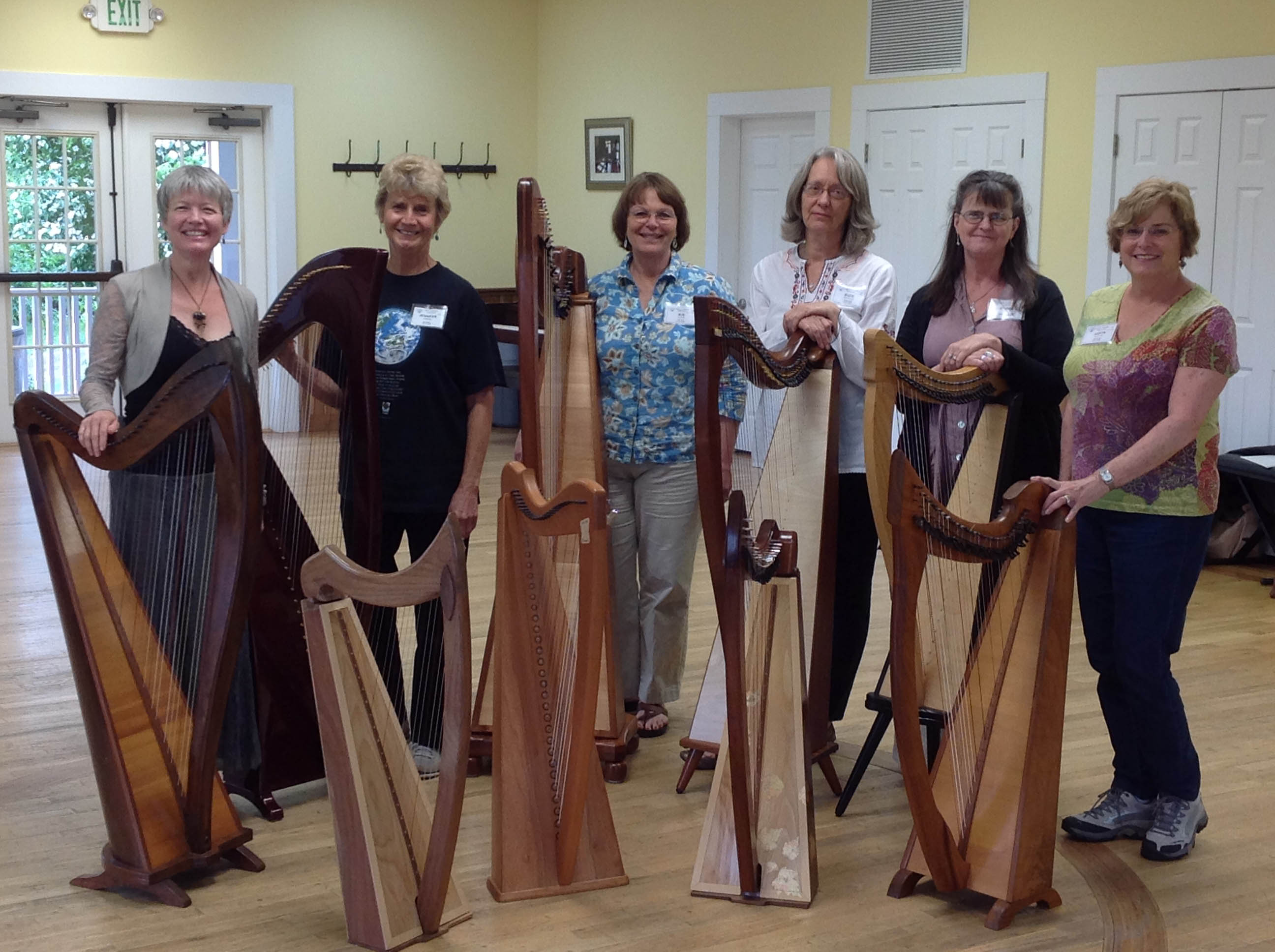 Folk Harp Class with instructor Lorinda Jones[/caption]
The four f's of why I continue to teach at John C Campbell Folk School.
I can teach music lessons on a weekly basis, twenty minutes from my house, so why would I drive 6.5 hours, sleep in a different bed, and not have continual access to internet for a week?! Because when I pull in the drive to the Keith House Community Room, I get the feeling one gets when they have returned home after a long absence. When I open the door in the mornings to the music studio and see the light streaming through the doors, highlighting the wood of the instruments, and I look out at the beautiful view of the mountains, it is like nothing else I can describe. And after just a couple of days with my students, it is like being reunited with family, even though we may have only just met on Sunday.
This year was no different. Well, it is always different, but I experienced those same feelings of being home, being united, and being inspired.
Folk Harp Class with instructor Lorinda Jones[/caption]
The four f's of why I continue to teach at John C Campbell Folk School.
I can teach music lessons on a weekly basis, twenty minutes from my house, so why would I drive 6.5 hours, sleep in a different bed, and not have continual access to internet for a week?! Because when I pull in the drive to the Keith House Community Room, I get the feeling one gets when they have returned home after a long absence. When I open the door in the mornings to the music studio and see the light streaming through the doors, highlighting the wood of the instruments, and I look out at the beautiful view of the mountains, it is like nothing else I can describe. And after just a couple of days with my students, it is like being reunited with family, even though we may have only just met on Sunday.
This year was no different. Well, it is always different, but I experienced those same feelings of being home, being united, and being inspired.



